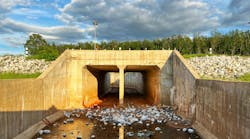Research aims to bring sustainable green solutions to Chesapeake Bay
Before over-harvesting, rising seawater temperatures and effects of human development, Chesapeake Bay, with an average depth of 21 feet, was virtually an unmolested waterway. Oyster reefs had been growing "from the ground up" for centuries. As one of nature's most efficient gifts in environmental protection, they helped sustain the exceptionally diverse marine species in the Bay.
With their ability to create dense structures —nearly 6,000 oysters might be found in a single square yard of oyster reef — these highly complex shell structures provide the perfect incubators for newly hatched oyster larvae and other fish species to grow, and their nooks and crannies are perfect protective habitats from predators for vulnerable marine life.
Matt Gray, Ph.d, assistant professor at the University of Maryland Center for Environmental Sciences (UMCES), and lead researcher at the UMCES Horn Point Laboratory on the Eastern Shore of Maryland, explains that the oyster population decades ago was so plentiful "they actually presented navigational difficulties as the reefs were extensive throughout the waterway, posing a danger to wooden-hulled boats traveling up the Chesapeake Bay."
Now, though the impacts of over-harvesting, rising seawater temperatures and effects of human development have reduced the once navigational hazards to less than 2% of its original magnitude.
"But the impact is more far reaching than a loss of food source," Gray says.
"These reefs are an essential shoreline protection from storm over wash; we lose erosion protection of coasts, loss of crucial wetlands, and we have reduced water filtration capacity."
As natural water treatment plants, oysters can filter water at upwards of 10 gallons of water a day, leading to a cleaner home for the numerous Chesapeake Bay species.
"The reefs are not only an excellent natural feature as habitat, once they reach an above-water size, they can buffer shorelines and dampen waves,” Gray said. “To reintroduce reefs our research is working to create a reef replica. By mimicking the real thing, we hope to attract the species to increase their population and sustainability."
Gray and his team are using a cement block configuration called Oyster Castles® with interlocking patterns and orientations as a scaffolding foundation for oysters.
He adds the blocks are put in seawater tanks that are on a pier on the river. The oyster larvae are introduced to those and once they attach to the block surface they can continue to mature. Larvae that have attached themselves are then called spat, and these blocks are then introduced to the Bay waters.
"As large numbers of oysters take to their new home, the community will eventually create a habitat on these scaffolding blocks,” Gray said. “Then, these artificial reefs will perform in the same manner as the originals. Ideally, you'd put the Castles out, make a structure, and larvae would show up. But because larval recruitment is highly variable over space and time, we set them ourselves to ensure we get spat on the Castles."
Gray adds that much of coastal shore buffer material is typically grey concrete material, but "these need to be maintained and modified. When you put the scaffolding blocks in and let Mother Nature do the work for you, it will adapt to the conditions and ultimately become living breakwaters, replicating the naturally occurring shore buffers."
And with nearly 12,000 miles of Bay shoreline, success in this endeavor would have widespread positive affect on marine species and coastlines.
From Baltimore to the Bahamas
For lead UMCES Investigator Professor Allen Place, creating the environmentally ideal material is now within reach.
Located in the inner harbor of downtown Baltimore, Place and his team at the Institute of Marine and Environmental Technology (IMET) are engaged in finding solutions for sustainable food resources, coastal marine protection and preservation, and much more.
To understand the complexities involved in creating the ideal oyster home in Maryland's Chesapeake Bay, Place takes us first to the Caribbean where his work with the properties of the carbonate sands in the Bahamas are now leading to exciting discoveries.
Called oolitic aragonite sand, this material precipitates out of warm tropical water bodies "at ridiculously high levels, and the Bahamas is renowned for their 500- square mile oolitic sand-harvesting operation,” Place said.
But what is oolitic sand, and why so special?
Place explains that these sands are organic, not silicate-based like typical beach sand, and are created through a scenario of natural environmental conditions.
"Ocean water, well known for taking up CO2 from the air, then combines with Calcium under the influence by ocean microalgae, and appropriate elevated pH [of the water] to precipitate the sand in the warm Bahamian waters.
Place continued: “This is called a 'whiting event' and results in the magnificent cays so common in the Bahamas. These shoreline 'oolitic sands' are actually the mineralization of calcium carbonate as aragonite. The result is an egg-shaped form called oolitic aragonite sand."
Place adds that these sands, in the Bahamas especially, continually form at staggering rates – about four billion pounds every year. And, as sustainable and renewable organics, they have distinct and desirable attributes because they are not garden-variety calcium carbonate but calcium aragonite – the same chemical formula but enough difference to make for a synthetic oyster reef dream recipe, which the team discovered through their research.
"Our investigation projects have shown that aragonite, which is the main compound of shell material, has a very high surface area, about 1.6 cubic metric meters per gram, which makes it perfect for adsorbing other materials and neutralizing them,” Place said. "For example, we demonstrated that when you add aragonite to a chicken house, it lowers ammonia emissions substantially. Normally in chicken litter, which is a widely used fertilizer, the microbial community breaks the uric acid (chickens' waste product) down to form ammonia. Those ammonia emissions are undesirable, but in the presence of aragonite the microbial community changes and no longer breaks down uric acid to ammonia. The other benefit is an improved nitrogen-phosphorous ratio, so the litter actually becomes better fertilizer when placed on the land."
With its high surface area and ability to retain water, aragonite is a perfect adsorbent, which is like putting a magnet on a plate of nails; an action where things are attracted to a surface, compared to absorbent where direct contact is needed, such as a spill of milk and a paper towel.
"Once we learned that this is how aragonite behaved, and knowing already that aragonite is the predominant material found in seashells, we asked, can we create aragonite material artificially in the laboratory by mimicking what happens in tropical waters,” Place said.
The IMET team found that by taking either natural or artificially created seawater, changing the pH a certain way, and increasing the temperature, “We get pure aragonite."
"Now that we can chemically make aragonite in the lab, our next step is to see how we can turn this into shell material that will mimic what oysters will settle on and create reefs,” Place said. “What we do know already is that the larvae don't like nice clean surfaces. They have receptor mechanisms that tell them to look for a surface with a microbiofilm on it, a nice coating of algae and bacteria for example, this is what attracts them as a good environment to set on.
And if replicating shell material for reefs can effectively sequester CO2 in the process, even better.
The CO2 Consequences of Concrete
UMCES researcher Professor Elizabeth North, along with Coral Defense project team members, are already working on developing that ideal recipe.
"It's not only the shape of the synthetic reefs that is important, it is also what they are made from,” North said. “We're at the very beginning of this technology but our goal is to develop a concrete mix that captures CO2."
She explains that CO2 is emitted in creating concrete and that she and her colleagues are trying to reduce the carbon footprint of concrete used in synthetic coral and oyster habitat.
"A lot of CO2 is released into the atmosphere because of the energy that is expended in making cement, an important material in concrete. Fuel for trucks, electricity to mine the raw materials, and then very high heat is needed to produce the cement."
It is the energy expended "when you fire up the massive kilns to above 1400 Celsius that cause the cement/concrete to be carbon emitting," that North says is a big contributor.
"What we would like to do is find a means to offset the carbon emissions by adding a carbon-neutral material that binds the CO2 and keeps it in the concrete,” North added. “On a small scale we are trying to develop a recipe with our lab-created oolitic material that will demonstrate this works with synthetic habitat for corals and oysters."
She continued: "This synthetic concrete could be used in habitat structures like reef balls, oyster castles, and other configurations. We might be able to make oyster shells with this mix. The goal is to come up with a shell/concrete product that supports many species, not just oysters."
And North adds that corals are particularly sensitive to increasing seawater temperatures, the direct result of increasing CO2. Any means to sequester CO2, regardless of source, is a win for the environment.
"The synthetic habitats like oyster castles could be established in key nearshore places to help with shoreline protection. They have to be in deep enough water to keep oysters from being exposed to cold temperatures in the winter, and not in the way of any navigational vessels."
Once the larvae in the water find the reef, the reef could keep growing, eventually becoming large enough to break waves for shoreline protection.
The results of all these researchers' projects could bring sustainable green solutions for the Chesapeake Bay (and elsewhere) to erosion prevention, the ability to better withstand storms and rising temperatures and sustainable and thriving habitats for marine- based food sources.


